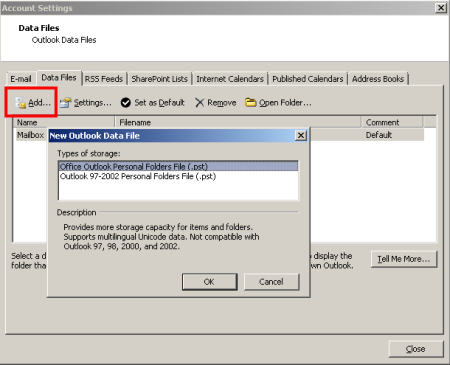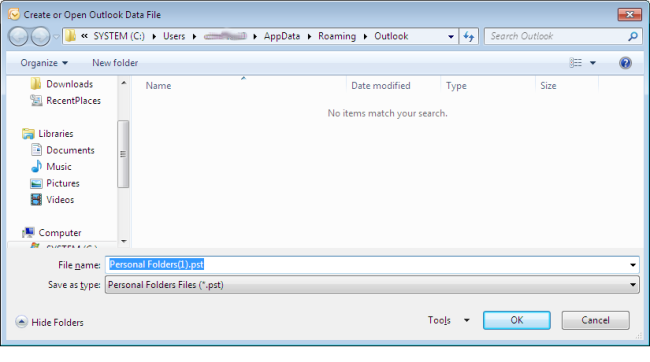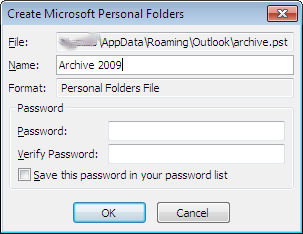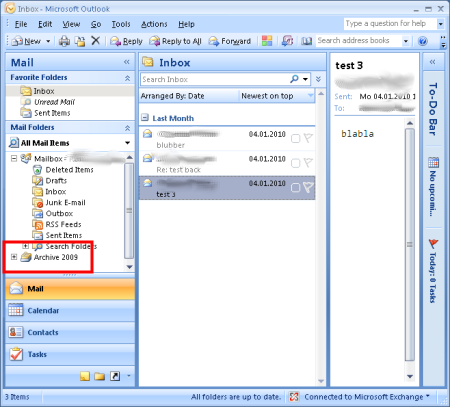|
Size: 1539
Comment:
|
Size: 3779
Comment:
|
| Deletions are marked like this. | Additions are marked like this. |
| Line 1: | Line 1: |
| ## page was renamed from Workstations/Windows7/MailSettings | |
| Line 5: | Line 6: |
| . Open the Control Panel, double-click the Mail icon: | We provide step-by-step instructions on how to configure your email client. We support Outlook 2016, Outlook365 and Mozilla Thunderbird. |
| Line 7: | Line 8: |
| {{attachment:Mail01.PNG}} | === Mozilla Thunderbird on Postfix provided by ISG.EE === |
| Line 9: | Line 10: |
| . Create a new profile: | . If you would like to use Mozilla Thunderbird as IMAP (recommended) client with the email server at ITET, please follow the steps outlined here: |
| Line 11: | Line 12: |
| {{attachment:Mail02.PNG}} | http://computing.ee.ethz.ch/Email/MailClient/MozillaThunderbird |
| Line 13: | Line 14: |
| . Click on Add... and enter a profile name e.g. your username or "default" | == .PST and .OST Storage Files == |
| Line 15: | Line 16: |
| {{attachment:Mail03.PNG}} | === What are .PST and .OST Files === |
| Line 17: | Line 18: |
| . When clicking OK, Outlook will automatically determine your First name, Last name and Email address. If the information is incorrect, you can correct it. |
==== PST Files ==== |
| Line 20: | Line 20: |
| {{attachment:Mail04.PNG}} | Since Outlook 2016, PST is not anymore use for emails and Konto informations. |
| Line 22: | Line 22: |
| . Click on Next | ==== OST Files ==== |
| Line 24: | Line 24: |
| . Outlook will try to automatically detect your email settings. If you are the owner of several accounts or aliases, you will be presented with the screen below. Select one of the accounts and click on Properties. In the field "E-mail adress", scroll to the right end to check whether this is the correct account. If you have selected the right account, click on OK. | OST files contain only your Outlook settings but not your emails. If all your emails are stored on the mail server, this configuration is called IMAP. Microsoft created a different version of IMAP called MAPI. |
| Line 26: | Line 26: |
| {{attachment:Mail05.PNG}} | OST files are still network sensitive but will never become as big as PST files because they only contain settings but no actual mails. |
| Line 28: | Line 28: |
| . If you see the screenshot below, you have configured your email account. Click on Finish and start Outlook. | === .PST and .OST Storage Location === |
| Line 30: | Line 30: |
| {{attachment:Mail06.PNG}} | After starting your email client, the appropriate file is created. OST files are stored in C:\Users\<USERNAME>\!AppData\Local\Outlook and will remain local. |
| Line 32: | Line 33: |
| == .PST and .OST Storage Location == | |
| Line 34: | Line 34: |
| Depending on your configuration, you might not need a .pst file anymore. Please see the table below to determine whether your configuration: | === Adding A Local Mail Storage File === |
| Line 36: | Line 36: |
| || Email Server \ Email Client || Thunderbird || Outlook || || || || || || MS Exchange (ID) || || || || Postfix (ISG.EE) || || || |
If your configuration uses .PST files, you should periodically check the size of that .PST file. The file size should not be bigger than 2GB. If the file grows to that size, you should create another .PST file e.g. as archive and move files to the archive. We show you how to create such an archive file. |
| Line 41: | Line 38: |
| After starting your email client, the appropriate file is created and stored in C:\Users\<USERNAME>\AppData\Local\Mail | . Open Outlook, click on File -> Data File Management |
| Line 43: | Line 40: |
| {{attachment:Mail08.PNG}} | {{attachment:PST01.png}} This will open the Account Settings dialog. Cllick on Add... to open the New Outlook Data File dialog. {{attachment:PST02.png}} . Select the appropriate file type and click OK. In the below screenshot, accept the location and '''select an appropriate filename e.g. archive2009.pst''' This name is the filename as you would see it in Windows Explorer. {{attachment:OL02.png}} . Click on OK. In the "Create Microsoft Personal Folders" in the field "File" you see the path and the filename as you specified it before. The name you can enter here is the '''display name in Outlook'''. This display is independent of the actual file name. For the sake of simplicity it is recommended to make them the same. If you want you can also specify a password to protect this .pst file. Make sure you don't forget the password as we will not be able to retrieve the password from the file. {{attachment:OL03.png}} . After clicking OK, the newly created archvie has been added to the list of mail folders, as you can see in the red frame. This archive has the same structure as the Mailbox just above it. {{attachment:PST05.png}} . You can now move or copy mails, folders or other items such as contacts from the Mailbox to the Archive to store them in the archive and save space on the mailserver. . After moving or copying items, right-click the "Archive 2009" and select "Close "Archive 2009" if you want to remove the archive from the folder list. The next time you start Outlook, the archive will not be in the folder list. {{attachment:PST06.png}} . However, if you want to re-add the archive to the folder list, you can do so by opening the file via the Menu "File" -> "Open" -> "Outlook Data File..." === Backup Of Local .PST Files === When you log out from your computer, the PST files are automatically copied from C:\Users\<USERNAME>\!AppData\Roaming\Outlook to H:\.win7_prof.V2\!AppData\Roaming\Outlook. During the night, a backup of your H: drive is made. ---- [[CategoryWNCL]] |
Contents
Configure Your Email Account
We provide step-by-step instructions on how to configure your email client. We support Outlook 2016, Outlook365 and Mozilla Thunderbird.
Mozilla Thunderbird on Postfix provided by ISG.EE
- If you would like to use Mozilla Thunderbird as IMAP (recommended) client with the email server at ITET, please follow the steps outlined here:
.PST and .OST Storage Files
What are .PST and .OST Files
PST Files
Since Outlook 2016, PST is not anymore use for emails and Konto informations.
OST Files
OST files contain only your Outlook settings but not your emails. If all your emails are stored on the mail server, this configuration is called IMAP. Microsoft created a different version of IMAP called MAPI.
OST files are still network sensitive but will never become as big as PST files because they only contain settings but no actual mails.
.PST and .OST Storage Location
After starting your email client, the appropriate file is created. OST files are stored in C:\Users\<USERNAME>\AppData\Local\Outlook and will remain local.
Adding A Local Mail Storage File
If your configuration uses .PST files, you should periodically check the size of that .PST file. The file size should not be bigger than 2GB. If the file grows to that size, you should create another .PST file e.g. as archive and move files to the archive. We show you how to create such an archive file.
Open Outlook, click on File -> Data File Management

This will open the Account Settings dialog. Cllick on Add... to open the New Outlook Data File dialog.

Select the appropriate file type and click OK. In the below screenshot, accept the location and select an appropriate filename e.g. archive2009.pst This name is the filename as you would see it in Windows Explorer.

Click on OK. In the "Create Microsoft Personal Folders" in the field "File" you see the path and the filename as you specified it before. The name you can enter here is the display name in Outlook. This display is independent of the actual file name. For the sake of simplicity it is recommended to make them the same. If you want you can also specify a password to protect this .pst file. Make sure you don't forget the password as we will not be able to retrieve the password from the file.

- After clicking OK, the newly created archvie has been added to the list of mail folders, as you can see in the red frame. This archive has the same structure as the Mailbox just above it.

- You can now move or copy mails, folders or other items such as contacts from the Mailbox to the Archive to store them in the archive and save space on the mailserver.
- After moving or copying items, right-click the "Archive 2009" and select "Close "Archive 2009" if you want to remove the archive from the folder list. The next time you start Outlook, the archive will not be in the folder list.

However, if you want to re-add the archive to the folder list, you can do so by opening the file via the Menu "File" -> "Open" -> "Outlook Data File..."
Backup Of Local .PST Files
When you log out from your computer, the PST files are automatically copied from C:\Users\<USERNAME>\AppData\Roaming\Outlook to H:\.win7_prof.V2\AppData\Roaming\Outlook. During the night, a backup of your H: drive is made.